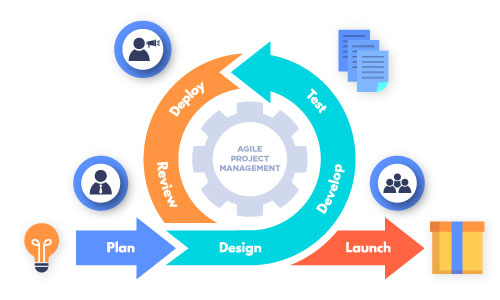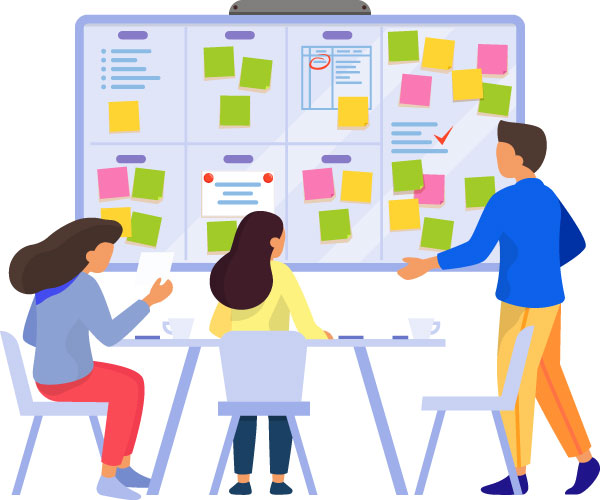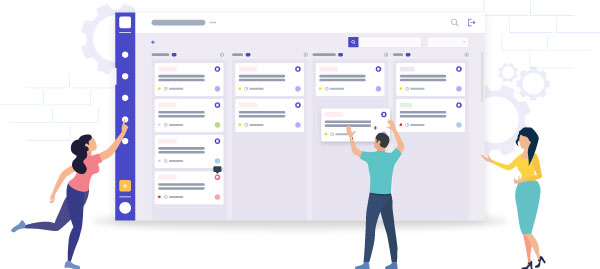A Detailed Beginner’s Guide To Agile Project Management
It has been some time since you are managing projects. The traditional methods of project management are working well for you. You know what the target is, you know the roadmap and you know there is a fixed outcome to your project. So, you give it out your heart and soul, work effortlessly well with your team members and then you deliver the project with astonishing results.
Simple right?
But what happens when the outcome of your project is capricious and sensitive to complete turnarounds?
How do you manage your project when the consumer or the scheduling or any variable in your project is bound to change and is ever-shifting?
These are some serious challenges you will start facing when you are handling projects that require extreme flexibility in the whole process.
This where Agile project management comes into play.
In this post we will explore:
- What is Agile project management?
- How and when do you apply the Agile methodology in your projects?
- The history of Agile development
And some other bits and pieces of information that will help you manage your projects efficiently and effectively without having your head over heels on figuring out how to manage it.
So, let’s begin.
What is an Agile project management?

Agile project management is often described as an iterative approach in managing your projects and delivering them.
Iterative is a fancy word so let’s understand it first.
Iteration is the repetition of a cycle, which previously produced successful results in an undertaking, this time to achieve varied but similar results. It means you are repeating a process which helped you previously achieve something, only this time it’s something else but similar.
How do we understand the Agile methodology?
Think of it like this, instead of working on a single massive project whose outcome is based on the success of each stage, in the Agile methodology you will be working on several different projects part of a bigger project upon whose completion you get an intended result
The primary goal of Agile is to produce shorter development life cycles with more frequent product releases. The Agile approach to project management is more focused on delivering results based on certain specific expectations from the end-user.
You will find that the industries most concerned with Agile development in their projects are the Software and App Development industries. Now you can relate to the apps you use on your phone which get continuously updated in their life cycle as we explain what is agile project management. The most popular frameworks in Agile methodology are Scrum and Kanban.
So, let us first understand what is Scrum, then Kanban and after that some defining differences between the two.
The Scrum framework

The Scrum framework in project management divides the work into time-based stages where the work undergoes an iterated process until a satisfying result is reached. These stages are called sprints. Don’t confuse it with the stages of the project life cycle, that is a completely different topic.
Scrum framework begins with the backlog of the product owner. This is a list of tasks or features that need to be implemented in the project.
There is a second backlog called the sprint backlog which is generated to contain the top points in the first backlog. The elements of the second backlog are then focused upon for the duration of one complete sprint.
Normally sprints go on for about a month and then move onto the next sprint.
Once the sprint is complete and there is still work pending, the remainder is added to the first backlog again and then the list is rearranged to prioritise what needs to be done according to the end user’s expectations and needs.
There is the Development Team, which as you can guess is the cross-functioning team that works on the sprints.
The Scrum process is headed by the Scrum Master, who is generally the product-owner. He is the one who guides the Development Team in the course of the sprints and instructs the team on what the result should be. Consider him the core that generates electricity for your appliances to work.
There are Daily Scrums held which typically go on for anywhere between 5-20 minutes. The Daily Scrum is a quick meeting between the Scrum Master and the Development Team where they discuss what was done on the previous day. what is to be done that day and what they will do the next day.
That is the bird’s-eye view of the Scrum framework.
The next popular framework in the Agile methodology is Kanban.
The Kanban framework

Kanban literally translates to ‘billboard’ in Japanese. When you start using Agile project management software with a Kanban-based system, you will understand exactly why.
The Kanban system is designed to get your work done efficiently through the use of the Kanban board. The Kanban board is the defining feature of this famous framework in the Agile methodology.
So, what is a Kanban board?
It’s a visual dashboard or overview of all the tasks that are being performed in this duration of the project. It contains sections like the tasks pending completion, tasks in progress, review, and cancelled tasks.
The Kanban board makes it easier for the team to maintain workflow in the project by giving easy access to members and notifying them about what is completed and what is expected to be completed.
The traditional means of implementing the Kanban-style was using a physical board.
The above photo is one of the first recorded uses of the Kanban system originated by Toyota Production System in around the 1940s.
For the digital era, many software development companies have launched their own project management software which implements their own tweaked and unique Kanban card system.
One of these is PeppyBiz, they offer a wide range of features and tools which are useful in Agile development. Their Kanban-based task management software helps any project manager to effectively drive the course of their projects.
Kanban is quite a simple framework, very user-friendly and easy to understand for beginners. But it does have its limitations as is the case with Scrum. That is why some projects are suitable for Scrum and some are suitable for the Kanban framework.
A detailed analysis is outside the scope of this post, so for now, let us review some basic differences between the Scrum approach to the Agile methodology and the Kanban approach.
Differences between Scrum and Kanban
For starters, Scrum is very structured with definite time-based sprints in place with the Scrum Masters and the Daily Scrums. These features, and others as well, are what define Scrum. It is very iterative in nature.
Kanban surprisingly is not iterative, it’s flexible and whatever needs to be repeated is based on progress reports and judgement. Also, the word ‘visual’ is very important when Kanban is defined because it is a visual workflow management system, you have to see and visualize every aspect.
Either of the above difference is not meant to undervalue any of the two. There are projects which require the Scrum-based approach to the Agile methodology and there are projects which find Kanban-based approach to Agile development more suitable.
It all falls down to the organisation and the nature of the project.
What’s different in Agile project management?
In the Agile methodology, it is a time-based undertaking that includes the repetitions of many processes again and again. It delivers the results in bits and pieces which finally culminates in the perfection of the final product.
An easy example is online video games. The developers have to consistently release bug fixes, game updates and security checks.
In the traditional approach to project management, it is simple. There is the conception, planning, execution, control and closure of the project. There are no excessive repetitions, once a stage is approved after thorough reviewing, it is inconvenient and cumbersome to go back to it. The project manager also plays a far more crucial role in the traditional approach.
History of the Agile methodology
In 2001, a group of people came together to tackle the challenges that were being faced in the industry concerning project delivery lags and delays.
This group of innovative thinkers consisted of Jeff Sutherland, Jon Kern, Mike Beedle and a few more professionals. Together they drew up what is now famously called the ‘Agile Manifesto’.
The Agile Manifesto is famous amongst practitioners of the Agile methodology and it is the work that lays out the fundamental principles and practices of Agile project management.
They were the people who pioneered Agile development and all of them are now well-known recognised names in the industry.
Conclusion
Implementing the Agile methodology is picking up great importance as the world shifts to a more dynamic medium with technology and the internet. Every individual project manager and an organisation as a whole need to learn and adapt, this puts Agile development at the forefront.
As a project manager, it is time you got yourself acquainted with the ins and outs of the profession, so understand agile project management and start implementing the right method to your projects for success.



